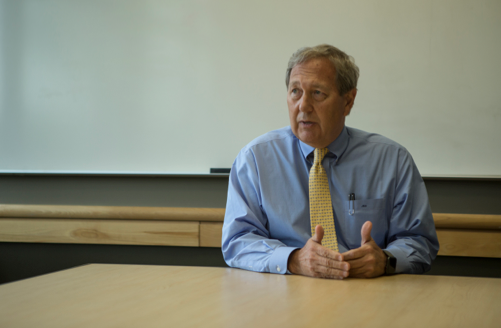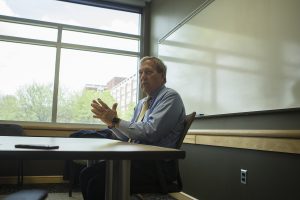Bruce Harreld speaks about the diversity, equity, and inclusion paradigm shift
Bruce Harreld addressed how the UI can move forward with its Diversity, Equity, and Inclusion plan as the Chief Diversity Office welcomes in new leadership and the department prepares for a paradigm shift.
May 6, 2019
As the University of Iowa prepares for a paradigmatic shift in its diversity, equity, and inclusion plan, President Bruce Harreld said his administration has successfully surveyed campus, identified real issues in the area, and set a fairly aggressive set of actions.
While many universities wait until a plan is solidified to recruit its leader, Harreld said TaJuan Wilson, the new UI associate vice president for Diversity, Equity, and Inclusion, was selected among three candidates to see the plan in its early states, shape it further, and own it.
“I think TaJuan is going to hit the ground pretty aggressively here,” Harreld said. “I’m really pleased with his personality, and I think a lot of us are. We’ve got a lot to do.”
Harreld said Wilson was the most action-oriented of the candidates, and Wilson probably looks forward to the amount of work coming to his plate. Primarily, Harreld said, the university wants to broaden the scope of the Chief Diversity Office by adding equity and inclusion.
“This is really about doing all that work in diversity, equity, and inclusion on our behalf,” Harreld said. “It’s about their creating an environment where they engage us, motivate us, support us, and actually measure how supportive we are as a community.”
RELATED: UI unveils Diversity, Equity, and Inclusion action plan
Now that data have been collected and the paradigm shift is at the starting line, Harreld said, the rest will be fun to implement. Among other things, he said, one of the two dimensions of the issue at the UI is a lack of minority representation in staff, faculty, and students on campus.
“We don’t have enough people of all sorts of minority groups in our midst,” Harreld said. “So we’ve got to make it better, broaden slates in our recruiting pools and our search pools. The more diverse our faculty is, the more likely the students will see their mentors in the group.”
He compared those metrics to a chicken and egg, saying the UI needs to work from both ends, faculty and students, to improve diversity, equity, and inclusion on campus. The second biggest barrier, he said, is the need for a shift in culture, which he believes is a much more powerful tool.
“In culture, first of all, we should understand the more diverse we are, the better the conversations, the more innovative the teams are, so the more diverse we are as a community,” Harreld said. “In many ways, the better we’ll do against our entire strategic agenda.”
According to the data, Harreld said, when there are teams composed only of similar people, that team’s filters fall short. Over time, he said, the UI should start recognizing diversity isn’t just the right thing to do, it’s the smart thing to do.
“It builds a broader base for creativity and innovation,” Harreld said. “I think that’ll take a while, but I think it starts with me and my management team, and I think it starts with us insisting that we have diverse candidate pools. We’ve got a lot to do — it’s an important issue.”






